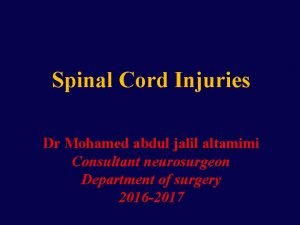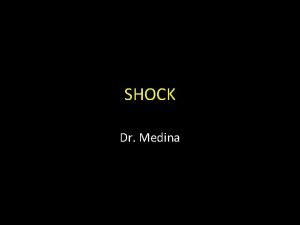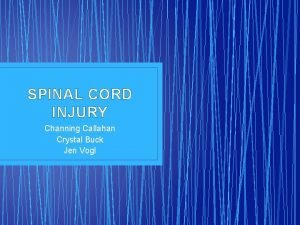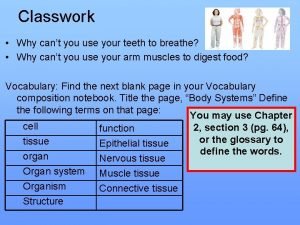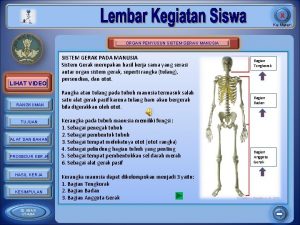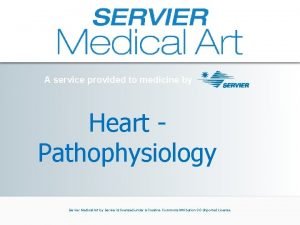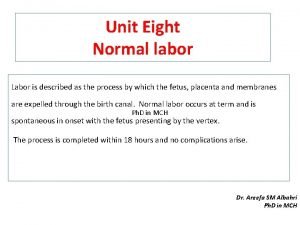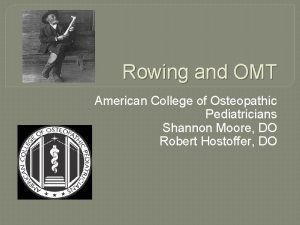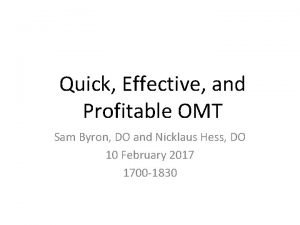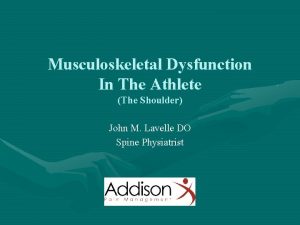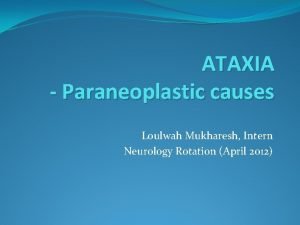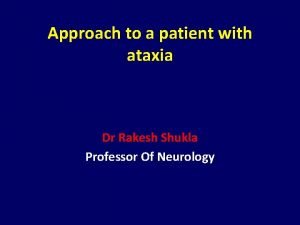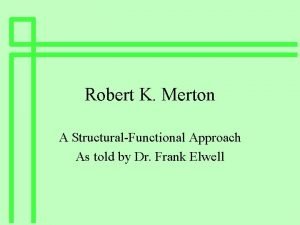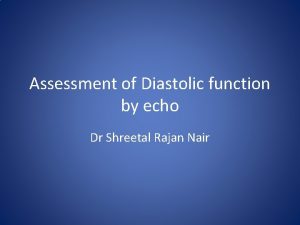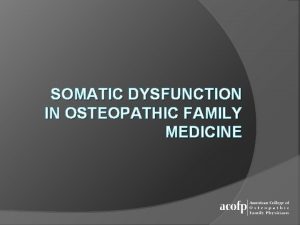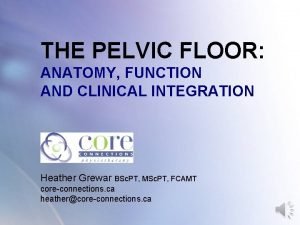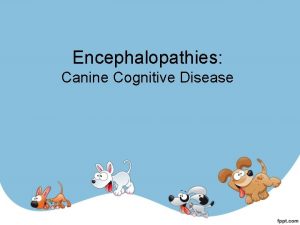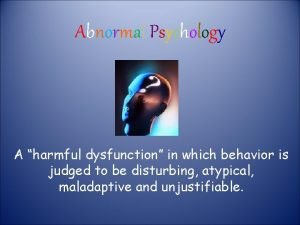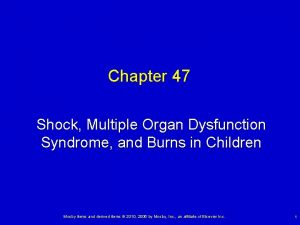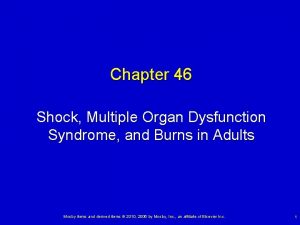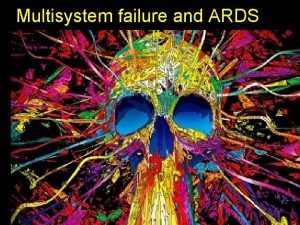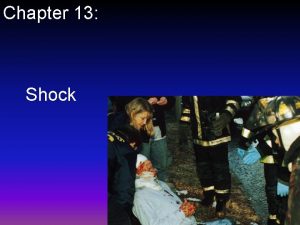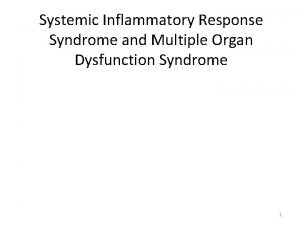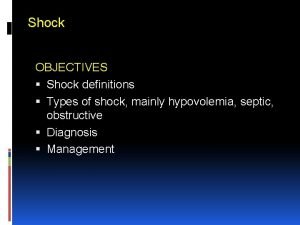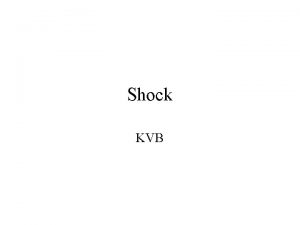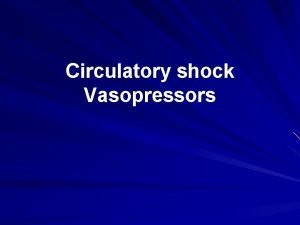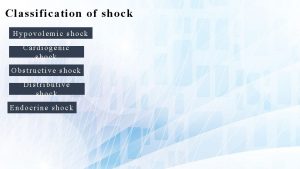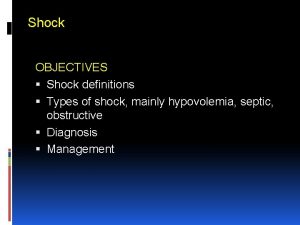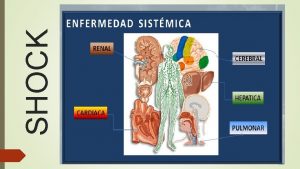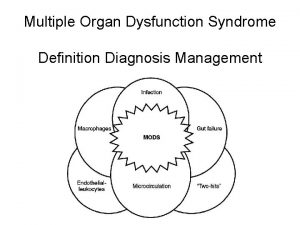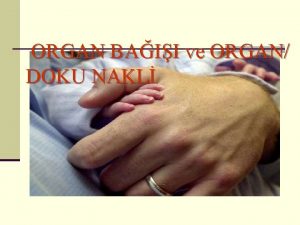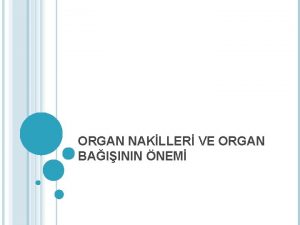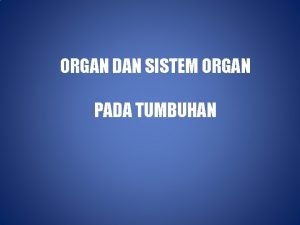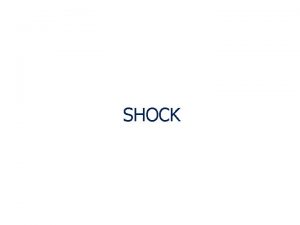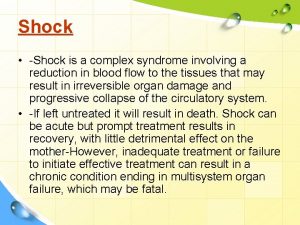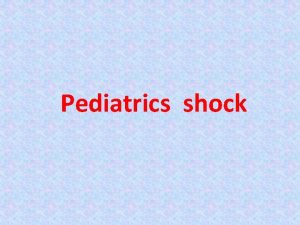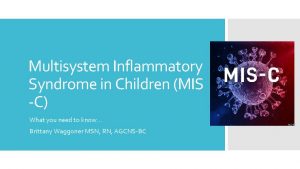Chapter 33 Shock and Multisystem Organ Dysfunction Syndrome














![Management • Optimize cardiac output and preload (left ventricular enddiastolic pressure [LVEDP]) of 14 Management • Optimize cardiac output and preload (left ventricular enddiastolic pressure [LVEDP]) of 14](https://slidetodoc.com/presentation_image_h2/4744aad139151fb9152d3d8f0832e4bb/image-15.jpg)


















- Slides: 33

Chapter 33 Shock and Multisystem Organ Dysfunction Syndrome Copyright © 2013 Wolters Kluwer Health | Lippincott Williams & Wilkins

Shock • Hypoperfusion, hypercoagulability, and activation of the inflammatory response • In hypoperfused states, the lack of sufficient oxygen causes the cells to convert to anaerobic metabolism. • If oxygen continues to be insufficient to meet cellular demands for energy, cell death ensues. • As more cells die, tissues and organs become progressively dysfunctional and eventually end-organ failure ensues. Copyright © 2013 Wolters Kluwer Health | Lippincott Williams & Wilkins

Three Stages of Shock • Stage 1. The body activates compensatory mechanisms in an effort to maintain circulatory volume, blood pressure, and cardiac output. – Normal vital signs and cerebral perfusion, and the shock state often goes unrecognized. • Stage 2. Compensatory mechanisms begin to fail, metabolic and circulatory derangements become more pronounced, and the inflammatory and immune responses may become fully activated. – Signs of dysfunction in one or more organs may become apparent. Copyright © 2013 Wolters Kluwer Health | Lippincott Williams & Wilkins

Three Stages of Shock (cont. ) • Stage 3. In the final, irreversible stage, cellular and tissue injury are so severe that the patient’s life is not sustainable even if metabolic, circulatory, and inflammatory derangements are corrected. – Full-blown multisystem organ dysfunction syndrome (MODS) may become evident. Copyright © 2013 Wolters Kluwer Health | Lippincott Williams & Wilkins

Question • Compensatory mechanisms in response to shock states result in which of the following? – A. Decreased urine output – B. Vasodilation of blood vessels – C. Decreased heart rate – D. Decreased cardiac output Copyright © 2013 Wolters Kluwer Health | Lippincott Williams & Wilkins

Answer • A. Decreased urine output • Rationale: In response to decreased venous return or decreased renal blood flow, compensatory mechanisms are initiated to maintain cardiovascular function and maintain blood volume. To maintain blood volume, the renin-angiotensin-aldosterone system is initiated for the kidneys to retain sodium and water. The net result is decreased urine output. Copyright © 2013 Wolters Kluwer Health | Lippincott Williams & Wilkins

Hypovolemic Shock • Result of inadequate circulating blood volume, caused by sudden blood loss, severe dehydration, or injuries that cause significant fluid shifts from the intravascular space to the interstitial space (e. g. , burns) Copyright © 2013 Wolters Kluwer Health | Lippincott Williams & Wilkins

Pathophysiology Copyright © 2013 Wolters Kluwer Health | Lippincott Williams & Wilkins

Assessment • History • Monitor vital signs. – Tachycardia, hypotension • Monitor respiratory status. • Use of nonsteroidal anti-inflammatory agents (NSAIDs), which can cause upper gastrointestinal bleeding • Clinical findings are related to the severity and acuity of volume loss. • Serum lactate, arterial p. H, serial hemoglobin, and hematocrit and coagulation Copyright © 2013 Wolters Kluwer Health | Lippincott Williams & Wilkins

Management • Volume administration • Large-bore 16 -gauge or larger for rapid infusion • Fluids are warmed during infusion to limit the negative effects of hypothermia. • Isotonic crystalloid solutions • Blood products and other colloid solutions if blood loss is the primary cause Copyright © 2013 Wolters Kluwer Health | Lippincott Williams & Wilkins

Question • Which of the following is not a common pathophysiological manifestation seen in patients with hypovolemic shock? – A. Altered mentation – B. Rapid and deep respirations – C. Cool and clammy skin – D. Bradycardia Copyright © 2013 Wolters Kluwer Health | Lippincott Williams & Wilkins

Answer • D. Bradycardia • Rationale: Patients with hypovolemic shock have signs and symptoms caused by poor organ perfusion. This includes tachycardia due to activation of the sympathetic nervous system; altered mentation, ranging from lethargy to unresponsiveness; rapid and deep respirations, which gradually become labored and shallow as the patient’s condition deteriorates; and cool, clammy skin. Copyright © 2013 Wolters Kluwer Health | Lippincott Williams & Wilkins

Cardiogenic Shock • Loss of ventricular contractility decreases stroke volume and cardiac output. • Neuroendocrine compensatory mechanisms are activated. • Increasing preload through retention of sodium and water • Increasing afterload (systemic vascular resistance) through vasoconstriction • These compensatory mechanisms further impair cardiac output, exacerbating the problem. Copyright © 2013 Wolters Kluwer Health | Lippincott Williams & Wilkins

Assessment • Develops within a few hours after the onset of myocardial infarction symptoms • Close monitoring for progressive hemodynamic compromise and clinical deterioration • Systolic blood pressure <90 mm Hg • Mean arterial pressure (MAP) <70 mm Hg • Cardiac index <2. 2 L/minute/m 2 • Pulmonary artery occlusion pressure (PAOP) >18 mm Hg Copyright © 2013 Wolters Kluwer Health | Lippincott Williams & Wilkins
![Management Optimize cardiac output and preload left ventricular enddiastolic pressure LVEDP of 14 Management • Optimize cardiac output and preload (left ventricular enddiastolic pressure [LVEDP]) of 14](https://slidetodoc.com/presentation_image_h2/4744aad139151fb9152d3d8f0832e4bb/image-15.jpg)
Management • Optimize cardiac output and preload (left ventricular enddiastolic pressure [LVEDP]) of 14 to 18 mm Hg. • Pharmacological agents to increase contractility • Antidysrhythmic agents, cardioversion, or pacing can help to restore a stable heart rhythm and enhance cardiac output. • Potassium, calcium, and magnesium replacement Copyright © 2013 Wolters Kluwer Health | Lippincott Williams & Wilkins

Management (cont. ) • Decreasing left ventricular workload • Pharmacotherapy: vasodilators may be administered to reduce SVR and LVEDP. • Intra-aortic balloon pump (IABP) or left ventricular assist device • Mechanical ventilation may be necessary to improve oxygen delivery to the tissues. • Scheduling physical care to ensure periods of rest Copyright © 2013 Wolters Kluwer Health | Lippincott Williams & Wilkins

Distributive Shock • The mechanism underlying all distributive shock states is vasodilation that causes decreased venous return. • Distributive shock states include – Neurogenic shock – Anaphylactic shock – Septic shock • In neurogenic shock, vasodilation results from a loss of sympathetic innervation to the blood vessels. • In anaphylactic shock and septic shock, vasodilation results from the presence of vasodilating substances in the blood. Copyright © 2013 Wolters Kluwer Health | Lippincott Williams & Wilkins

Neurogenic Shock • Neurogenic shock results from loss or disruption of sympathetic tone most often due to severe cervical or upper thoracic spinal cord injury. – Signs and symptoms include hypotension, severe bradycardia, and warm, dry skin. – Volume resuscitation – Vasoconstrictors may be used. Copyright © 2013 Wolters Kluwer Health | Lippincott Williams & Wilkins

Anaphylactic Shock • Anaphylaxis is an allergic reaction that evokes a lifethreatening hypersensitivity response. • Ig. E-mediated anaphylaxis occurs as a result of the immune response to a specific antigen after being exposed and forming antibodies. • Non-Ig. E responses (anaphylactoid reactions) occur without the presence of Ig. E antibodies and can occur the first time the person is exposed to the antigen. Copyright © 2013 Wolters Kluwer Health | Lippincott Williams & Wilkins

Anaphylactic Shock (cont. ) • WBCs secrete chemical mediators causing systemic vasodilation. • Increased capillary permeability • Bronchoconstriction, coronary vasoconstriction, and urticaria • Arterial vasodilation causes maldistribution of blood volume to tissues, and venous dilation decreases preload, thus decreasing cardiac output. • Increased capillary permeability • Death due to circulatory collapse or extreme bronchoconstriction can occur within minutes or hours. Copyright © 2013 Wolters Kluwer Health | Lippincott Williams & Wilkins

Clinical Manifestations of Anaphylaxis • Generalized erythema • Stridor • Urticaria/pruritus • Laryngeal edema • Anxiety and restlessness • Bronchoconstriction with stridor • Dyspnea/wheezing • Chest tightness • Hypotension • Angioedema Copyright © 2013 Wolters Kluwer Health | Lippincott Williams & Wilkins

Assessment • History of allergies is used to avoid known allergens and is the best way to prevent anaphylactic shock. • Anaphylactic shock may occur without any known predisposing factors. Copyright © 2013 Wolters Kluwer Health | Lippincott Williams & Wilkins

Management • Remove the offending antigen. • Reverse effects of chemical mediators. • Restore adequate tissue perfusion. • Oxygen • Subcutaneous or IV antihistamine • Epinephrine • Corticosteroids, bronchodilators • Mechanical ventilation is required. • Vasoconstrictors and positive inotropic agents Copyright © 2013 Wolters Kluwer Health | Lippincott Williams & Wilkins

Question • What is the initial therapy of choice for the treatment of anaphylactic shock? – A. Epinephrine – B. Rapid infusion of normal saline – C. Dobutamine – D. Norepinephrine Copyright © 2013 Wolters Kluwer Health | Lippincott Williams & Wilkins

Answer • A. Epinephrine • Rationale: Epinephrine is given to reverse the vasodilation and bronchoconstriction. Copyright © 2013 Wolters Kluwer Health | Lippincott Williams & Wilkins

Septic Shock • Complex interactions among invading microorganisms and the immune system, the inflammatory system, and the coagulation system • Proinflammatory cytokines are released. • Activation of the immune response, complement system, and coagulation system • Increased vascular permeability • To balance the proinflammatory response, antiinflammatory cytokines are released causing an “out of control” inflammatory response. • Cardiovascular, pulmonary, and hematologic alterations Copyright © 2013 Wolters Kluwer Health | Lippincott Williams & Wilkins

Sepsis • The systemic response to known infection, manifested by two or more of the following conditions as a result of infection: – Temperature greater than 100. 4°F (38°C) or less than 96. 8°F (36°C) – Heart rate greater than 90 beats/minute – Respiratory rate greater than 20 breaths/minute or arterial carbon dioxide tension Pa. CO 2 less than 32 mm Hg – White blood cell (WBC) count greater than 12, 000 cells/mm 3 or less than 4, 000 cells/mm 3 OR more than 10% immature (band) forms Copyright © 2013 Wolters Kluwer Health | Lippincott Williams & Wilkins

Assessment • Early signs of changes in mental status, an increased respiratory rate, and either hyper- or hypothermia • Lab studies • Cultures, (CBC), SMA-7, ABGs, lactate level, end-tidal carbon dioxide monitoring • Pulmonary artery catheterization with mixed venous oxygen (Sv. O 2) monitoring • CT, chest and abdominal x-rays Copyright © 2013 Wolters Kluwer Health | Lippincott Williams & Wilkins

Management • Identify and treat the cause. • Volume repletion • Mechanical ventilation • Maintain adequate cardiac output. • Correct coagulopathies • Nutritional support Copyright © 2013 Wolters Kluwer Health | Lippincott Williams & Wilkins

Multiorgan System Failure (MODS) • The pathophysiology of similar to sepsis and SIRS • Endothelial injury, inflammatory mediators, disturbed hemostasis, and microcirculatory failure • Tissue hypoxia caused by microvascular thromboses contributes to MODS. • Typically, the first organs to manifest signs of dysfunction are the lungs and kidneys. Copyright © 2013 Wolters Kluwer Health | Lippincott Williams & Wilkins

Assessment and Management • Identifying SIRS and signs and symptoms of organ failure • Multiple scoring systems exist to determine the extent of MODS, including the Sepsis-Related Organ Failure Assessment (SOFA) • Treatment is supportive and directed at specific organ systems. Copyright © 2013 Wolters Kluwer Health | Lippincott Williams & Wilkins

Question • Which of the following classifications best describes septic shock? – A. Hypovolemic shock – B. Cardiogenic shock – C. Vasodilatory shock – D. Anaphylactic shock Copyright © 2013 Wolters Kluwer Health | Lippincott Williams & Wilkins

Answer • C. Vasodilatory shock • Rationale: Widespread vasodilation and maldistribution of blood flow associated with septic shock result in decreased venous return to the heart, resulting in a shock state. Hypovolemic shock is caused by dehydration or hemorrhage. Cardiogenic shock occurs when the heart fails to function as a pump as a result of myocardial infarction, abnormal heart rate or rhythm, or impaired diastolic filling. Anaphylactic shock occurs as a result of an antibody-antigen reaction. Copyright © 2013 Wolters Kluwer Health | Lippincott Williams & Wilkins
 What is the definition of multisystem trauma?
What is the definition of multisystem trauma? Reactive airways dysfunction syndrome
Reactive airways dysfunction syndrome Hangman fracture
Hangman fracture Shock normovolemico
Shock normovolemico Spinal shock vs neurogenic shock
Spinal shock vs neurogenic shock Spinal shock symptoms
Spinal shock symptoms Spinal shock vs neurogenic shock
Spinal shock vs neurogenic shock Organ and organ system
Organ and organ system Cell tissue organ organ system organism
Cell tissue organ organ system organism Cells are the building blocks of all living things
Cells are the building blocks of all living things Organ penyusun sistem gerak pada manusia
Organ penyusun sistem gerak pada manusia Foto rontgen efusi pleura
Foto rontgen efusi pleura Organ penyusun sistem koordinasi
Organ penyusun sistem koordinasi Creative commons
Creative commons Dengue shock syndrome
Dengue shock syndrome Where does negative selection occur
Where does negative selection occur What is true labor
What is true labor Orgasmic dysfunction
Orgasmic dysfunction Caliper motion of ribs
Caliper motion of ribs Sam byron
Sam byron Rib somatic dysfunction
Rib somatic dysfunction True labour pain symptoms
True labour pain symptoms Conjunction dysfunction meaning
Conjunction dysfunction meaning Loulwah mukharesh
Loulwah mukharesh Positive romberg test causes
Positive romberg test causes Robert merton structural functionalism
Robert merton structural functionalism Ivrt echo
Ivrt echo Urt
Urt Nulliparous
Nulliparous Executive dysfunction
Executive dysfunction Canine cognitive dysfunction
Canine cognitive dysfunction Nzrsi
Nzrsi What is harmful dysfunction
What is harmful dysfunction Chapter 14 bleeding shock and soft tissue injuries
Chapter 14 bleeding shock and soft tissue injuries


